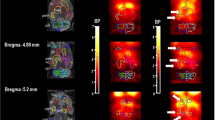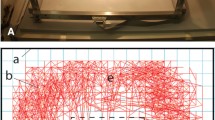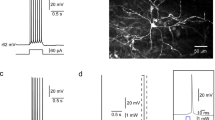Abstract
Recent studies have demonstrated the existence of two distinct regions within the nucleus accumbens (N.Acc) known as “core” and “shell”. In order to investigate whether the behavioral functions of excitatory amino acid receptors differed between these two subregions, rats were administered microinjections of 2-amino-5-phosphonovaleric acid (AP-5), a competitive NMDA antagonist (0, 0.05, 0.2, 0.5, 1.0 µg/0.5 µl) into selected central and medial regions of the accumbens. The central and medial sites were assumed to correspond approximately to core and shell subregions, respectively. The animals were tested in two exploratory tasks: the open field and a novel object test. In the open field test, AP-5 significantly decreased peripheral locomotion and center rearing frequency in the central but not the medial group. Locomotion and rearing were not affected by AP5 infusion into a control site, the anterior dorsal striatum (ADS). In the novel object test, animals were tested in the same open field, with prior habituation, and with several novel objects placed within it. In this test, infusions of AP-5 (0, 1.0 µg/0.5 µl) decreased the number and duration of contacts with the novel objects in the central but not the medial group. In addition, peripheral and center locomotion were decreased by AP-5 infusions into the central site, whether objects were present or not. In contrast, AP-5 infusions into the medial site elicited an increase in peripheral locomotion in both stimulus conditions. These findings provide behavioral-pharmacological evidence that the central and medial subregions of the nucleus accumbens can be differentiated. Moreover, the results suggest that exploratory motor responses may be dependent on glutamate-coded input to the nucleus accumbens area corresponding to the core region.
Similar content being viewed by others
References
Albin RL, Makowiec RL, Hollingsworth ZR, Dure IV LS, Penney JB, Young AB (1991) Excitatory amino acid binding sites in the basal ganglia of the rat: a quantitative autoradiographic study. Neuroscience 46:35–48
Alheid GF, Heimer L (1988) New perspectives in basal forebrain organization of special relevance for neuropsychiatric disorders; striatopallidal, amygdaloid, and corticopetal components of substantia innominata. Neuroscience 27:1–39
Bakshi VP, Kelley AE (1991) Dopaminergic regulation of feeding behavior: Differential effects of haloperidol infusion into three striatal subregions. Psychobiology 19[3]:223–232
Berendse HW, Groenewegen HJ, Lohman AHM (1992) Compartmental distribution of ventral striatal neurons projecting to the mesencephalon in the rat. J Neurosci 12:2079–2103
Bouyer JJ, Park DH, Joh TH, Pickel VM (1984) Chemical and structural analysis of the relation between cortical inputs and tyrosine hydroxylase-containing terminals in the rat neostriatum. Brain Res 302:267–275
Brog JS, Deutch AY, Zahm DS (1991) Afferent projections to the nucleus accumbens core and shell in the rat. Soc Neurosci Abstr 17:454
Burns LH, Everitt BJ, Robbins TW (1991) Functional interactions of limbic afferents to the ventral striatum with mesolimbic dopamine: studies of conditioned reinforcement and locomotor activity in the rat. Soc Neurosci Abstr 17:1249
Cheramy A, Romo R, Godeheu G, Baruch P, Glowinski J (1986) In vivo presynaptic control of dopamine release in the cat caudate nucleus: II. Facilitatory or inhibitory influence ofl-glutamate. Neuroscience 19:1081–1090
Dawbarn D, Pycock CJ (1981) Motor effects following application of putative excitatory amino acid antagonists to the region of the mesencephalic dopamine cell bodies in the rat. Naunyn-Schmiedeberg's Arch Pharmacol 318:100–104
Deutch AY, Cameron DS (1991) Pharmacological characterization of dopamine systems in the nucleus accumbens core and shell. Neuroscience 46:49–56
Donzanti BA, Uretsky NJ (1983) Effects of excitatory amino acids on locomotor activity after bilateral microinjection into the rat nucleus accumbens: possible dependence on dopaminergic mechanisms. Neuropharmacology 22:971–981
Douglas RJ, Isaacson RL (1964) Hippocampal lesions and activity. Psychon Sci 1:187–188
Falls WA, Miserindino MJD, Davis M (1992) Extinction of fearpotentiated startle: blockade by infusion of an NMDA antagonist into the amygdala. J Neurosci 12:854–863
Freund TF, Powell JF, Smith AD (1984) Tyrosine hydroxylase-immunoreactive boutons in synaptic contact with identified striatonigral neurons, with particular reference to dendritic spines. Neuroscience 13:1189–1216
Fuller TA, Russchen FT, Price JLP (1987) Sources of presumptive glutamergic/apartergic afferents to the rat ventral striatopallidal region. J Comp Neurol 258:317–338
Girault JA, Barbeito L, Spampinato U, Gozlan H, Glowinski J, Besson MJ (1986) In vivo release of endogenous amino acids from the rat striatum: further evidence for a role of glutamate and aspartate in corticostriatal neurotransmission. J Neurochem 47:98–106
Groenewegen HJ, Vermeulen-Van der Zee E, te Kortschot A, Witter MP (1987) Organization of the projections from the subiculum to the ventral striatum in the rat. A study using anterograde transport of phaseolus vulgaris leucoagglutinin. Neuroscience 23:103–120
Hannigan JH, Springer JE, Isaacson RL (1984) Differentiation of basal ganglia dopaminergic involvement in behavior after hippocampectomy. Brain Res 291:83–125
Hassler R, Haug P, Nitsch C, Kim JS, Paik K (1982) Effect of motor and premotor cortex ablation on concentrations of amino acids, monamines, and acetylcholine and on the ultrastructure in rat striatum. A confirmation of glutamate as the specific cortico-striatal transmitter. J Neurochem 38:1087–1098
Heimer L, Zahm DS, Churchill L, Kalivas PW, Wohltmann C (1991) Specificity in the projection patterns of accumbal core and shell in the rat. Neuroscience 41:89–125
Kelley AE, Stinus L (1985) Disappearance of hoarding behavior after 6-hydroxydopamine lesions of the mesolimbic dopamine neurons and its reinstatement withl-dopa. Behav Neurosci 99:531–545
Kelley AE, Throne LC (1992) NMDA receptors mediate the behavioral effects of amphetamine infused into the nucleus accumbens. Brain Res Bull 29:247–254
Kimble DP (1968) Hippocampus and internal inhibition. Psychol Bull 70:285–295
Kita H, Kitai ST (1990) Amygdaloid projections to the frontal cortex and the striatum in the rat. J Comp Neurol 298:40–49
Koob GF, Bloom FE (1988) Cellular and molecular mechanisms of drug dependence. Science 242:715–723
Koob GF, Stinus L, Le Moal M (1981) Hyperactivity and hypoactivity produced by lesions to the mesolimbic dopamine system. Behav Brain Res 3:341–359
McDonald AJ (1991a) Organization of amygdaloid projections to the prefrontal cortex and associated striatum in the rat. Neuroscience 44:1–14
McDonald AJ (1991b) Topographical organization of amygdaloid projections to the caudotoputamen, nucleus accumbens, and related striatal-like areas of the rat brain. Neuroscience 44:15–33
McGeer PL, McGeer EG, Scherer U, Singh K (1977) A glutamatergic corticostriatal pathway? Brain Res 128:369–373
McGeorge AJ, Faull RLM (1989) The organization of the projection from the cerebral cortex to the striatum in the rat. Neuroscience 29:503–537
Meredith GE, Agolia R, Arts MPM, Groenewegen HJ, Zahm DS (1992) Morphological differences between projections neurons of the core and shell in the nucleus accumbens of the rat. Neuroscience 50:149–162
Mogenson GJ, Nielsen M (1984a) A study of the contribution of hippocampal-accumbens-subpallidal projections to locomotor activity. Behav Neural Biol 42:38–51
Mogenson GJ, Nielsen M (1984b) Neuropharmacological evidence to suggest that the nucleus accumbens and subpallidal region contribute to exploratory locomotion. Behav Neural Biol 42:52–60
Mogenson GJ, Jones DL, Yim CY (1980) From motivation to action: functional interface between the limbic system and the motor system. Prog Neurobiol 14:69–97
Mount H, Welner S, Quirion R (1989) Glutamate stimulation of [3H] dopamine release form dissociated cell cultures of rat ventral mesencephalon. J Neurochem 52:1300–1310
Pennartz CMA, Boeijinga PH, Lopes da Silva FH (1990) Locally evoked potentials in slices of the rat nucleus accumbens: NMDA and non-NMDA receptor mediated components and modulation by GABA. Brain Res 529:30–41
Pennartz CMA, Dolleman-Van der Weel MJ, Lopes da Silva FH (1992) Differential membrane properties and dopamine effects in the shell and core of the rat nucleus accumbens studied in vitro. Neurosci Lett 136:109–112
Pulvirenti L, Swerdlow NR, Koob GF (1989) Microinjection of a glutamate antagonist into the nucleus accumbens reduces psychostimulant locomotion in rats. Neurosci Lett 103:213–218
Pulvirenti L, Swerdlow NR, Koob GF (1991) Nucleus accumbens NMDA antagonist decreases locomotor activity produced by cocaine, heroin or accumbens dopamine, but not caffeine. Pharmacol Biochem Behav 40:841–845
Robbins TW, Cador M, Taylor JR, Everitt BJ (1989) Limbic-striatal interactions in reward-related processes. Neurosci Biobehav Rev 13:155–162
Roberts PJ, Sharif NA (1978) Effects ofl-glutamate and related amino acids upon the release of3H-dopamine from rat striatal slices. Brain Res 157:391–395
Robinson TG, Beart PM (1988) Excitant amino acid projections from rat amygdala and thalamus to nucleus accumbens. Brain Res Bull 20:467–471
Save E, Poucet B, Foreman N, Buhot M-C (1992) Object exploration and reactions to spatial and nonspatial changes in hooded rats following damage to parietal cortex or hippocampal formation. Behav Neurosci 106:447–456
Sesack SR, Pickel VM (1990) In the rat nucleus accumbens, hippocampal and catecholaminergic terminals converge on spiny neurons and are in apposition to each other. Brain Res 527:266–279
Shimizu N, Duan S, Hori T, Oomura Y (1990) Glutamate modulates dopamine release in the striatum as measured by brain microdialysis. Brain Res Bull 25:99–102
Smith AD, Bolam JP (1990) The neural network of the basal ganglia as revealed by the study of synaptic connections of identified neurones. Trends Neurosci 13:259–265
Somogyi P, Bolam JP, Smith AD (1981) Monosynaptic cortical input and local axon collaterals of identified stratonigral neurons. A light and electron microscopic study using the Golgiperoxidase transport-degeneration procedure. J Comp Neurol 195:567–584
Tallaksen-Greene SJ, Wiley RG, Albin RL (1992) Localization of striatal excitatory amino acid binding site subtypes to striatonigral projection neurons. Brain Res 594:165–170
Voorn P, Gerfen CR, Groenewegen HJ (1989) Compartmental organization of the ventral striatum of the rat: immunohistochemical distribution of enkephalin, substance P, dopamine, and calcium-binding protein. J Comp Neurol 289:189–201
Walaas I, Fonnum F (1979) The effects of surgical and chemical lesions on neurotransmitter candidates on the nucleus accumbens. Neuroscience 4:209–216
Yang CR, Mogenson GJ (1984) Electrophysiological responses of neurones in the nucleus accumbens to hippocampal stimulation and the attenuation of the excitatory responses by the mesolimbic dopaminergic system. Brain Res 324:69–84
Zaborszky L, Alheid GF, Beinfeld MC, Eiden LE, Heimer L, Palkovits M (1985) Cholecystokinin innervation of the ventral striatum: a morphological and radioimmunological study. Neuroscience 14:427–453
Zahm DS, Brog JS (1992) On the significance of subterritories in the “accumbens” part of the rat ventral striatum. Neuroscience 50:751–767
Zahm DS, Heimer L (1990) Two transpallidal pathways originating in rat nucleus accumbens. J Comp Neurol 302:437–446
Author information
Authors and Affiliations
Rights and permissions
About this article
Cite this article
Maldonado-Irizarry, C.S., Kelley, A.E. Differential behavioral effects following microinjection of an NMDA antagonist into nucleus accumbens subregions. Psychopharmacology 116, 65–72 (1994). https://doi.org/10.1007/BF02244872
Received:
Revised:
Issue Date:
DOI: https://doi.org/10.1007/BF02244872




